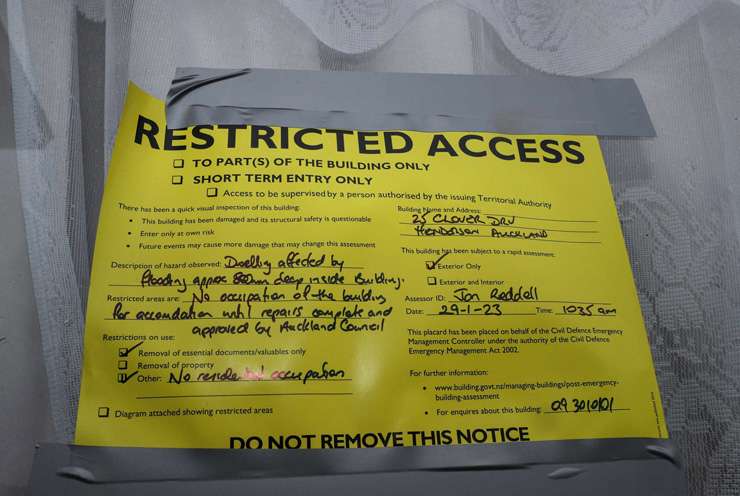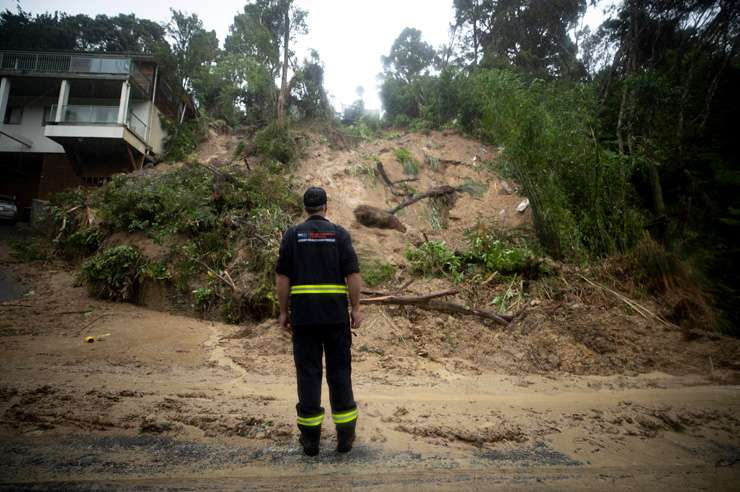ANALYSIS: Auckland Council has been placing red, yellow and white stickers on damaged buildings, which indicate the degree of damage and whether buildings may be accessed.
If your property has been damaged (or you think it may become damaged due to a potential slip), contact your insurer immediately. EQC covers flood and storm damage on defined areas of residential land, where there’s a current private insurance policy for the home, which includes fire insurance (most do). From June 30 2021, if you have a current private insurance policy for your home, you’ll have a single point of contact and be able to lodge your EQCover claim directly through your private insurer.
The landowner’s private insurer will assess, manage, and settle the entire claim – including the EQCover portion of a claim on behalf of Toka Tū Ake EQC.
Landslides
Start your property search
If someone’s building has been stickered because of a landslide, in general the owner of the land is responsible for repairing a slip on their land. If neighbours’ land has moved and caused damage, there is not an automatic obligation to repair it, even if it affects the neighbouring owner, unless they caused the slip by their own negligence. However if there is the possibility of future slips, as a result of the recent flooding all landowners have a general duty of care to act reasonably to prevent or mitigate damage to a neighbour’s property due to a hazard on their land once they are aware of it. A land owner (or occupier) owes a duty of care to their neighbours to ensure that hazards occurring on the land (whether natural or man-made) do not cause loss or harm. That duty obliges an owner to take reasonable steps to remove or reduce such hazards where it is foreseeable that a neighbouring property might be harmed. The duty depends on knowledge of the hazard and the ability to foresee the consequence of not dealing with it.

Flood damage indicated by a yellow sticker on a West Auckland property. Photo / Hayden Woodward
If you think there is the possibility of future damage contact your neighbour, the council and your insurer in writing advising of your concern and asking them to take the necessary steps to prevent further damage. For an assessment contact either a Chartered Professional Engineer who specialises in geotechnical engineering, or a Professional Engineering Geologist. Do this in liaison with your insurer as the cost may be dealt with as part of your claim, or your insurer may have experts which they prefer to use. If you are unhappy with their advice/recommendations you may appoint your own independent expert.
If you believe that your neighbour is not taking the requisite steps to protect your property, you may be able to seek a mandatory injunction requiring work to be carried out to protect your property. These steps will need input from professionals and will need to take into account the reasonable time a neighbour might need to take to obtain expert advice.
If your property is in danger of slipping and may cause damage advise your insurer and seek professional geotechnical advice urgently to ascertain what steps you might need to take. On obtaining your report and receiving your insurers decision you may need legal advice if you are unhappy with the outcome/advice and to ensure you minimise your exposure to costs and damages to third parties.
Stickers
If your property has been stickered, notify your insurer and do not take any repair action without contacting your insurer first, and follow the rules according to the sticker which should set out what you can or can’t do. Stickering is different in different council areas.
Initial stickering in an emergency response situation such as in Auckland after recent flooding. There is usually a more in-depth examination later. Ideally the wait should not be too long but if there are a lot of assessments to make this can take longer. For example finer weather might be needed for a geotechnical engineer to assess matters when the property has dried out. The Council can reassess and change the level of stickering on further more detailed examination.

Members of FENZ Urban Search and Rescue assess red stickered homes in Titirangi, Auckland, after the first wave of devastating floods that hit the city. Photo / Dean Purcell
A red or yellow sticker is a formal, legal notice under the Building Act 2004, and ignoring it could result in a fine as well as being unsafe, and the council can take enforcement action against people who breach. Owners may arrange emergency work or have the building demolished as an emergency measure without consent if it is necessary to protect public safety however you may not enter the property without council’s approval if it has been red stickered. Liaising with your insurer, council and professionals is advised. The necessary building consents also need to be obtained for the work and code compliance certificates on completion. Some repair work which is like for like, may not require building consents but owners should seek advice on that. MBIE has information on exempt building work.
When the repairs have been completed, contact council and ask them to lift the sticker/notice. They will usually reinspect, or this may happen as part of obtaining the code compliance certificate. Remember that if you try to sell your house after carrying out remedial work, if the damage was serious, potential purchasers will want to see that a building consent and a code compliance certificate was obtained to give them confidence about the repairs.
If you are unhappy about the level of stickering on your property, you can get your own expert to review and challenge the council’s decision and you would be recommended to seek legal advice. Subpart 6 of the Building Act 2004 sets out the Special provisions for dangerous, affected, and insanitary buildings.
Stickering may be because of damage to a building or the threat of further slips and landslides.
- Red stickers mean the building is dangerous and should not be entered. Council should be contacted before any professionals enter the building and/or property.
- Yellow stickers means the building is potentially dangerous and identifies restrictions for use, and/or parts of the building. They should not be entered other than as set out on the sticker.
- White stickers mean the building is safe for normal use even if the building may have still suffered damage.
* As told to Catherine Masters
- Joanna Pidgeon is a lawyer with Auckland law firm Pidgeon Judd.


















































































